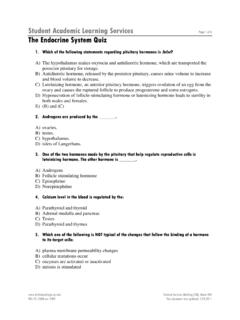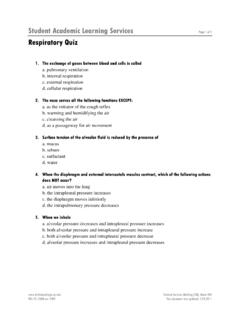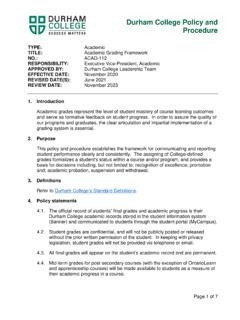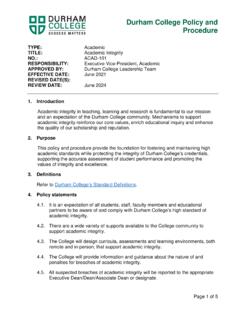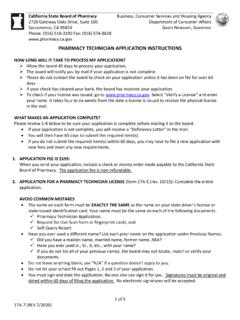Transcription of Thermodynamics - Basic Concepts - Durham College
1 Student Academic Learning Services Page 1 of 14. Thermodynamics Basic Concepts Contents Thermodynamics Basic Concepts .. 1. Laws about gases .. 1. Charles' Law .. 1. Boyle's Law .. 2. Charles' and Boyle's Laws combined .. 2. Ideal Gas Law .. 2. Relevant Concepts and definitions for gases .. 2. Pressure .. 2. Barometric Pressure .. 3. Manometric Pressure .. 3. Absolute Pressure .. 3. Specific Volume .. 3. Temperature .. 4. General Physics Stuff .. 4. 4. Energy and Work .. 4. Power .. 6. And Back to Energy!! .. 6. Problems .. 7. Piston pressure problem .. 7. Gas law problems .. 7. Weight, mass, density, etc.. 9. Answers ..10. Laws about gases Charles' Law Volume is directly proportional to temperature: V = cT, where c > 0 is constant.
2 Student Services Building (SSB), Room 204. ext. 2491. This document last updated: 8/3/2011. Student Academic Learning Services Page 2 of 14. Scientist Jacque Charles noticed that if air in a balloon is heated, the balloon expands. For an ideal gas, this relationship between V and T should be linear (as long as pressure is constant). Boyle's Law Pressure is inversely proportional to volume: = , where a > 0 is a constant.. Robert Boyle noticed that when the volume of a container holding an amount of gas is increased, pressure decreases, and vice versa (while the temperature is held constant). Note that this is not a linear relationship between p and V.
3 Charles' and Boyle's Laws combined = , where k is a constant.. Mathematically, you can combine the two laws above: Ideal Gas Law This law combines the relationships between p, V, T and mass, and gives a number to the constant! The ideal gas law is: pV = nRT, where n is the number of moles, and R is universal gas constant. The value of R depends on the units involved, but is usually stated with units as: R = J/mol K. For air, one mole is g (= kg), so we can do a unit conversion from moles to kilograms. 1 287 . = =.. This means that for air, you can use the value R = 287 J/kg K. If you use this value of R, then technically the formula should be written as pV = mRT, where m represents the mass of air in kg (and we avoid having to do any calculations with moles.)
4 Relevant Concepts and definitions for gases Pressure Pressure is defined as a force applied over the surface area of an object. The formula defining pressure is: = .. Student Services Building (SSB), Room 204. ext. 2491. This document last updated: 8/3/2011. Student Academic Learning Services Page 3 of 14. For example, picture a person standing on a box that sits on the floor. The person weighs 800 N. pounds and the box, viewed from above, is the shape of a square with a side length of 1 meter. The pressure of the box on the floor would be: . =.. 800. =. 1 ! = 800. ! Pressure is measured in Pascals (Pa), and 1 Pascal is defined as 1. = 800 "#. N/m2.
5 Therefore, the pressure on the floor is 800 Pa. Another common unit for pressure is pounds per square inch (psi). Barometric Pressure Also known as atmospheric pressure, this is pressure applied to any object that is in an atmosphere, on earth. Standard atmospheric pressure, at sea level at a temperature of 25 C. is kPa. Barometric pressure is measured with a barometer. Manometric Pressure Also known as the gauge pressure, this is the internal pressure of the system, and does not include the barometric pressure. Manometric pressure is measured with a manometer. Note that this value can actually be negative (see below). Absolute Pressure This is the total amount of pressure including both the manometric and barometric pressures.
6 You can use the formula: Absolute Pressure = Barometric Pressure + Manometric Pressure With this formula, it is important to note that absolute pressure cannot be negative, but manometric pressure can and will be negative whenever the absolute pressure of the system is lower than the barometric pressure. This happens when you create a vacuum (or partial vacuum). inside something. Specific Volume The specific volume of an object is defined as its volume ( space occupied) per unit mass. The symbol is a lower case v (which is sometimes written in italics), and the formula can be written as: $=% where & is the total volume.. The normal unit of measurement for specific volume is m3/kg.
7 Specific volume is also the reciprocal of density: $ = (, where ) (Greek letter rho) is the density of an object (or substance). '. Student Services Building (SSB), Room 204. ext. 2491. This document last updated: 8/3/2011. Student Academic Learning Services Page 4 of 14. Temperature Temperature is a less straightforward concept than pressure. Temperature is a measure of the amount of thermal energy that exists in a physical space, relative to a zero point of energy, which we define as absolute zero. In science, temperature is usually measured on the Kelvin scale, where 0 K is absolute zero, and K is the freezing point of water ( K = 0 C). General Physics Stuff Force In physics, force is defined using Newton's 2nd Law: *+, = #, where is the mass of an object, # is the objects acceleration and Fnet is the amount of unbalanced force being applied to the object.
8 The unit for force is the Newton (N), where 1 N = 1 kg m/s2. Conceptually, 1 N is the amount of force required to move a mass of 1 kg at a rate of acceleration equal to 1 m/s2. Any unit for force should always be made up of a unit for mass (in this case kg) multiplied by a unit for acceleration (m/s2). In fact, the formal definition of pounds force (lbf, the Imperial unit of force) is 1 lbf = 1 slug ft/s2. or the force required to accelerate a mass of 1 slug at a rate of acceleration of 1 ft/s2. Since one slug equals pounds mass (lb), we get the useful conversion factor: 1 lbf = lb ft/s2, which is very useful for changing between weights in lbf to masses in lbm, and vice versa.
9 Energy and Work There are many different types of energy, and different formulas for calculating it, but they should all be measured with the same unit, the Joule. The following are a few different mathematical definitions of energy. Kinetic Energy = mv2. where m is mass and v is speed (or velocity without direction). Kinetic Energy is the energy of motion anything that is moving has kinetic energy. The higher the speed, the more kinetic energy an object has. Gravitational Potential Energy = m g h where m is mass, g is gravitational acceleration, and h is the height of the object relative to a reference point ( the ground). The higher something is above the ground, the more potential it has to fall, increase speed, and thus gain kinetic energy.
10 Student Services Building (SSB), Room 204. ext. 2491. This document last updated: 8/3/2011. Student Academic Learning Services Page 5 of 14. In general, all forms of energy have something to do with movement, even including thermal and electrical energy, while potential energy is the potential for movement to happen at some point. For example, electric potential is the potential for an object with charge ( an electron) to move through an electric field. Chemical potential energy can be thought of as the energy held in some substances that can be released through a chemical reaction, such as burning a fuel for heat. Work is defined as the change in the level of energy of a system, so it is also measured in Joules.

